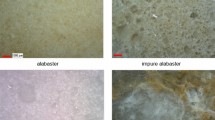Abstract
The gypsum karst in the Western Ukraine spreads through a large territory covering more than 20,000 km2 and is represented by a range of stages (evolutionary types), from deep-seated through subjacent to entrenched. Correspondingly, hydrogeological settings of karst development, circulation patterns and chemical characteristics of groundwaters differ substantially between the respective areas. Based on 1,800 analyses, this paper summarises hydrochemistry of the gypsum-hosting Miocene aquifer. The majority of sampling has been performed in conjunction with a study regime of gypsum solution rates by means of standard tablets. In this study, which included 53 tablet stations representing varying conditions of water-rock interaction, 644 weight-loss measurements were made over the period 1984–1992. The highest rates are characteristic of entrenched karst although active dissolution is localised along well-defined sinking streams with short underground courses, rare vertical percolation paths and the water table. Lower but still quite substantial rates are characteristic of subjacent and deep-seated (confined) karst. However, the overall dissolution removal is greater due to higher flow through the gypsum and the larger area of rock-solvent contact. The results are generalised in order to derive the approximate solution rates characterising major situations and to be suitable for modeling purposes.






Similar content being viewed by others
References
Aksem SD, Klimchouk AB (1991) Study of equilibria in the rock-solution system and some other problems of sulfate karst hydrochemistry, vol 1 (russ.). Kiev Karst& Speleology Center, Kiev 25 p
Andrejchuk VN (1984) The regularities of karst development in the south-east of the zone of junction between the Russian platform and Carpathian foredeep (russ.). PhD Thesis, Chernovitsky University
Andrejchuk VN (1988) The tectonic factor and peculiarities of the sulfate karst of Bukovina: geology, geomorphology and hydrogeology of karst (russ.). Sverdlovsk, 66 p
Gams I (1981) Comparative research of limestone solution by means of standard tablets. In: Proceedings of the 8th International Congress of Speleology Bowling Green, Kentucky 1:273–275
Garrels RM, Christ CL (1965) Solutions, Minerals and Equilibria. Harper and Row, New York, p 497
Klimchouk AB et al. (1985) The study of geological and hydrogeological conditions of karst development of the Pridnestrovsky Podolia in the connection with the establishment of a karstological monitoring site. In: Sokolovskij IL, Klimchouk AB (eds) Fizicheskaja Geografija i Geomorfologija, vol. 32 (russ.). Karst of the Ukraine. Vyshcha Shkhola, Kiev, pp 47–54
Klimchouk AB et al. (1988) Regime study of gypsum karst activity in the Western Ukraine (russ.). Inst. Geol. Nauk, Kiev 55 p
Klimchouk AB et al. (1996) Dissolution of gypsum from field observations. In: Gypsum Karst of the World. Int J Speleol, Theme issue, 25(3–4):37–48
Klimchouk AB (1996) Gypsum karst in the Western Ukraine. In: Klimchouk AB, Lowe DJ, Cooper AH, Sauro U (eds) Gypsum karst of the world Int J Speleol Theme issue 25(3–4):263–278
Klimchouk AB (1997a) Artesian speleogenetic settings. In: Proceedings of the 12th International Congress of Speleology vol. 1 La Chaux-de-Fonds, Switzerland, pp 157–160, 10–17 August 1997
Klimchouk AB (1997b) Speleogenetic effects of water density differences. In: Proceedings of the 12th International Congress of Speleology vol. 1 La Chaux-de-Fonds, Switzerland, pp 161–164, 10–17 August 1997
Klimchouk AB (2000b) Speleogenesis of the great gypsum mazes in the Western Ukraine. In: Klimchouk A, Ford D, Palmer A, Dreybrodt W (eds) Speleogenesis: evolution of karst aquifers. Huntsville, National Speleological Society, pp 261–273
Klimchouk AB (2000a) Speleogenesis under deep-seated and confined settings. In: Klimchouk A, Ford D, Palmer A, Dreybrodt W (eds) Speleogenesis: evolution of karst aquifers. National Speleological Society, Huntsville, pp 244–260
Klimchouk AB, Andrejchuk VN (1988) Geologic and hydrogeologic conditions of the development of large gypsum caves in the Western Ukraine and their genesis. Peshchery (Caves) (russ). Gypsum and Anhydrite Caves. University Perm, Perm, pp 12–25
Shestopalov VM (ed) (1989) Water exchange in hydrogeological structures of the Ukraine. Water exchange under natural conditions (russ.). Naukova dumka, Kiev 288 p
Wigley TML (1973) Chemical evolution of the system calcite-gypsum-water. Can J Earth Sci 10:306–315
Acknowledgements
The information that has been summarised in this paper has been taken from different projects. Data consolidation and analysis as well as some additional field studies were part of the risk of subsidence due to evaporite solution (ROSES) Project ENV4-CT97–0603 funded by the European Commission Framework IV Programme.
Author information
Authors and Affiliations
Corresponding author
Rights and permissions
About this article
Cite this article
Klimchouk, A.B., Aksem, S.D. Hydrochemistry and solution rates in gypsum karst: case study from the Western Ukraine. Environ Geol 48, 307–319 (2005). https://doi.org/10.1007/s00254-005-1277-3
Received:
Accepted:
Published:
Issue Date:
DOI: https://doi.org/10.1007/s00254-005-1277-3




